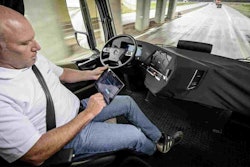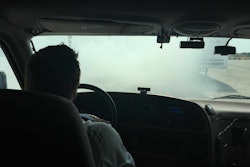 From left: CCJ Technology Editor Aaron Huff; Modern Transportation’s Patrick Cozzens; Angie Buchanan, Melton Truck Lines; and John Elliot, Load One.
From left: CCJ Technology Editor Aaron Huff; Modern Transportation’s Patrick Cozzens; Angie Buchanan, Melton Truck Lines; and John Elliot, Load One.With driver turnover hovering at 100-plus percent, a panel was assembled at the CCJ Symposium in Birmingham, Ala., Wednesday to tackle two of the biggest buzzwords in trucking: recruitment and retention.
Patrick Cozzens, president, Modern Transportation, says 70 percent of his company’s freight is dedicated, allowing drivers to be home at night. That has been a positive draw for applicants and helped keep his turnover rate for first five months this year at 23 percent.
“When we see driver turnover it is in their first 30 days. What causes that turnover is the person you hire. We actually rank and score [applicants],” he says, adding people with more jobs in the past 5 years get a lower score.
Angie Buchanan, vice president of safety and human resources, Melton Truck Lines, and the only participant that hires drivers directly from CDL school, says her drivers are gone three weeks at a time, making applicant education critical through the hiring process.
“The most important thing we’ve focused on is preparing the families,” she says. “We offer to talk to the spouse and the family and offer a spouse orientation. We think it’s pretty important for the spouse to interview us.”
Buchanan says its also critical to set forth clear expectations for all parties involved.
“The reality of the job is important,” she adds. “We actually lose 49 percent of the applicants we bring in and its because of the realities of the job. When they start the flatbed application and the physical agility, they wash out.”
“The biggest driver of turnover is expectations not being met,” says John Elliot, chief executive officer, Load One, adding Load One changed its recruiter compensation plan to focus on retention versus hiring, “to make sure they shared the pain in turnover.”
Integrating technology with a workforce that likes the freedom of the open road without scaring them off can be a management challenge.
“Our culture is everything we do is all about safety,” Cozzens says. “When a driver starts with us, a senior driver does all that training.”
Cozzens says his company has found success in having drivers train drivers versus using a manager because they can more efficiently explain why the company uses certain technologies since they’re actually on the road using them.
Elliott adds convincing drivers that technology is for their own benefit comes down to education.
“Drivers have this vision that dispatchers are just going to sit there and stare at them in the cab all day [through a camera],” he says. “It’s a balance of trying to educate them on how these items are going to increase their safety and [are] not an intrusion into their privacy.”
Buchanan says driver-facing cameras have allowed the company to help coach drivers, adding it’s been a constant public relations campaign.
“We have a number of testimonials that both the forward and driver-facing cameras have been life changing for that driver,” she says. “That’s the one piece of technology that I wouldn’t leave home without.”
Another challenge of integrating technology, Buchanan adds, is assuring the drivers they are more than just a number. To foster personalization, Melton has made a push for terminal executives to meet with drivers when they come through town.
“I think it becomes a culture that it’s not just a steering wheel holder and that it is a person,” she says.
Conventional wisdom is that money solves all problems, but Buchanan says it’s tough to standardize driver pay with conditions that can often vary wildly.
“Variability in pay is one of the biggest drivers of turnover, and we’ve got to get a handle on it,” she says.
“Incentives are great but they’re a double edged sword,” Elliott says. “We’ve put together a points/reward system and we really made the program to focus our [return on investment] on retention. Where we really wanted [drivers] to be rewarded is on doing the things they are supposed to be doing.”
Quarterly safety bonuses at Modern Transport, Cozzens adds, can bump driver pay between 3 and 5 percent.
Regardless of how they’re paid, managing a mix of fresh CDL-holders and veteran drivers has pushed Melton Truck Lines to train its managers to overlook “cultural differences” between Millennials and Baby Boomers.
“Millennials learn differently. You can’t expect to park them in front of an instructor for 8 hours a day and not fiddle with their phone,” she says. “But you can’t put your Boomers in front of a computer all day long because they don’t like that either.”
Educating Boomer-generation trainers on how to deal with the new generation of drivers, Buchanan says, is ongoing.
“Millennials have been raised to get a lot of feedback, a lot of handholding,” she says, “where our Boomers have been taught to just go figure it out.”













